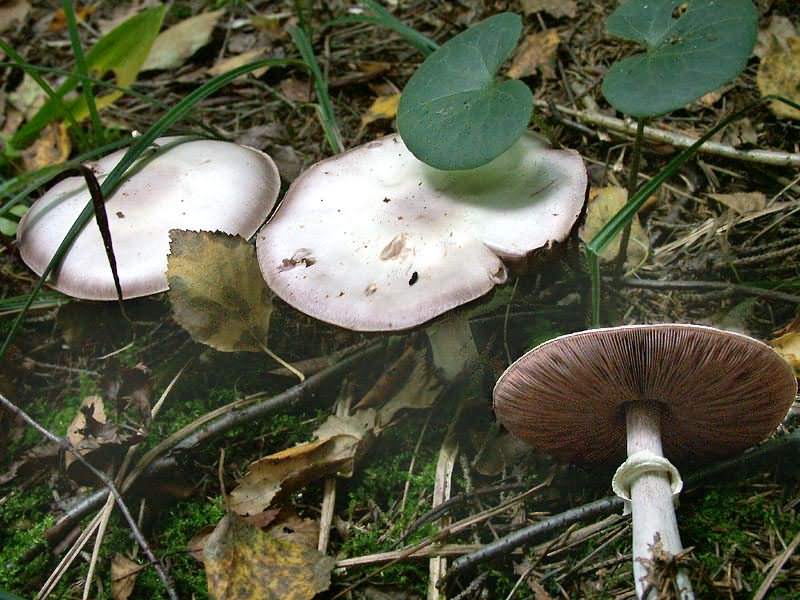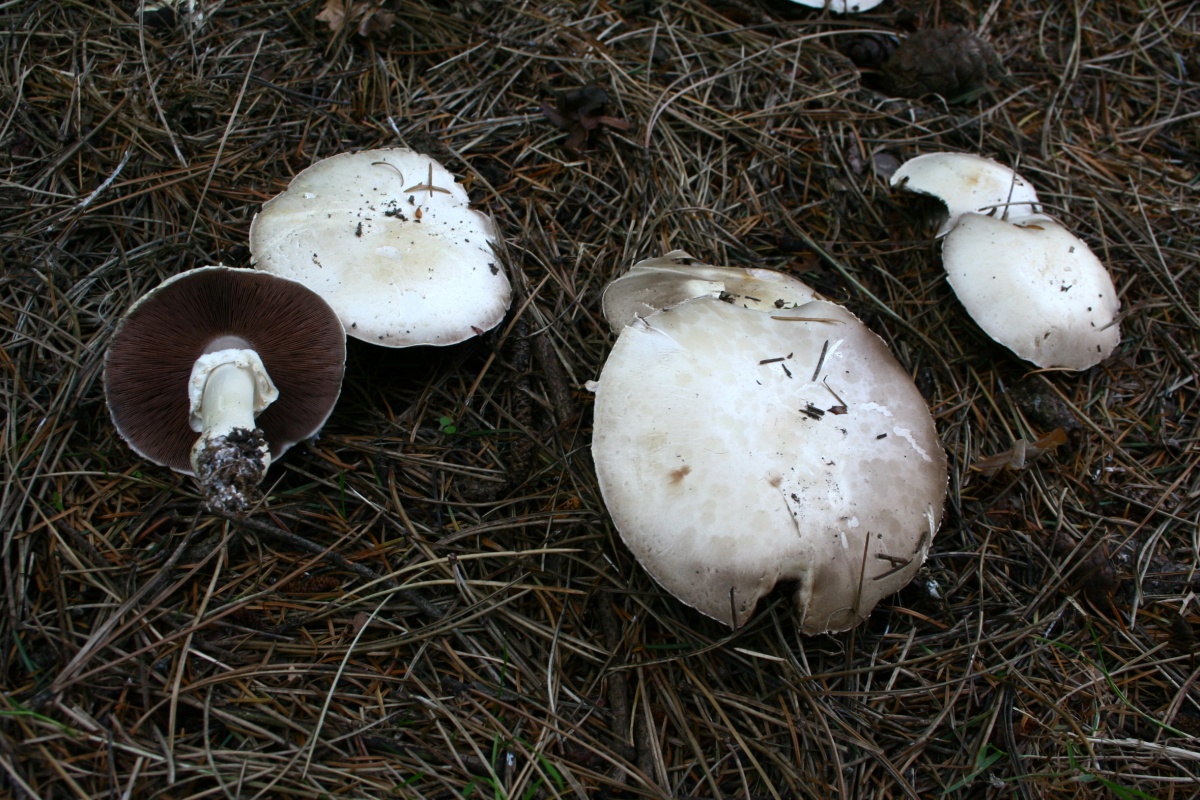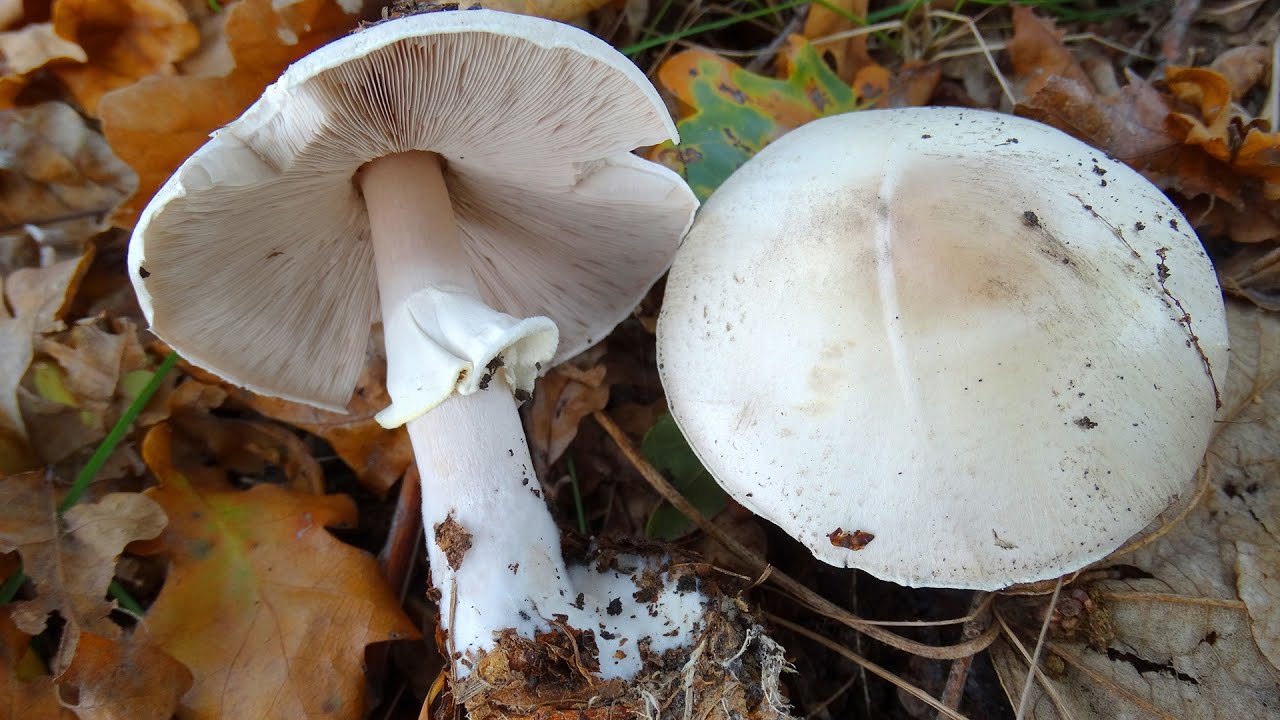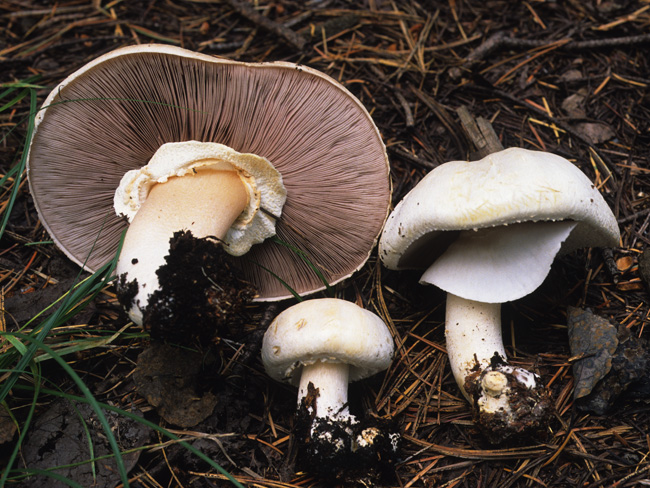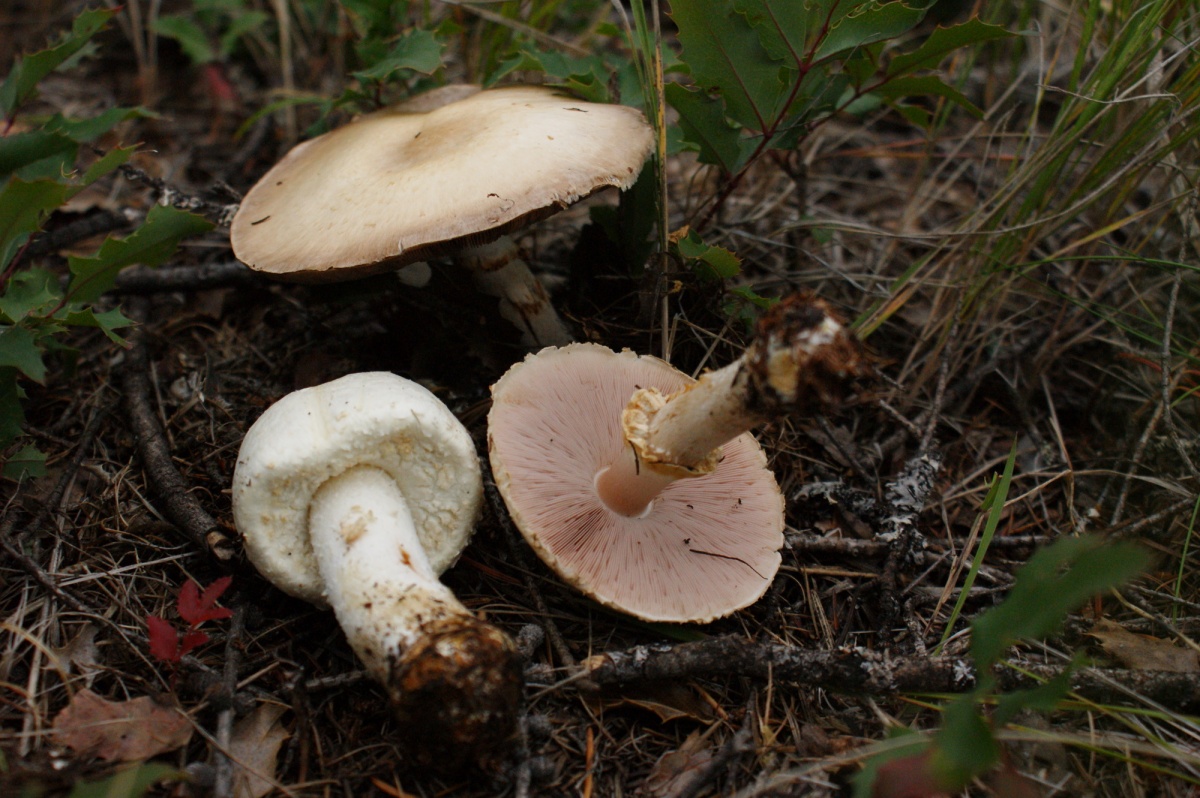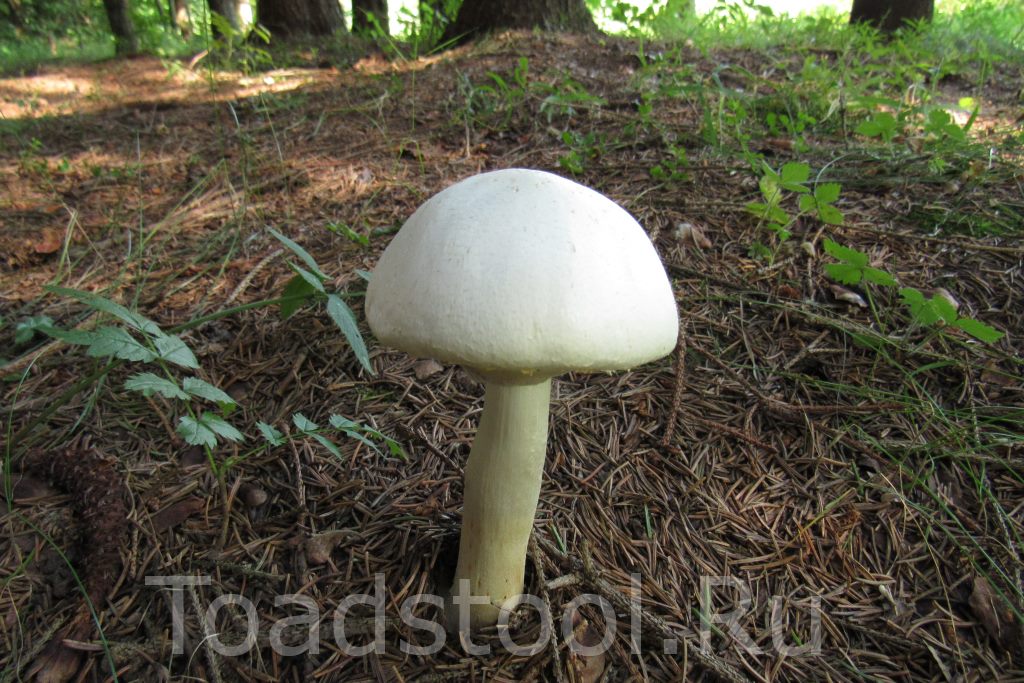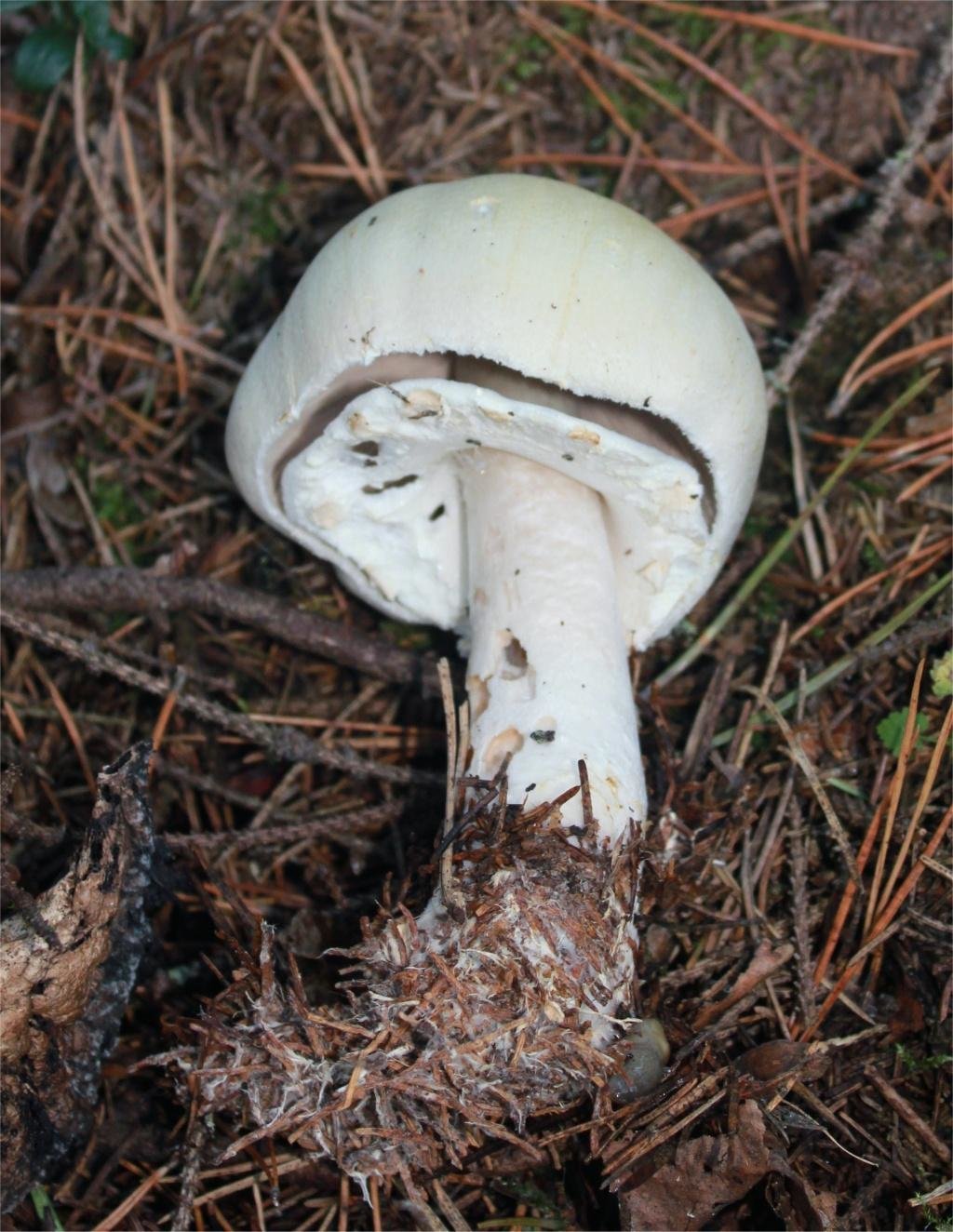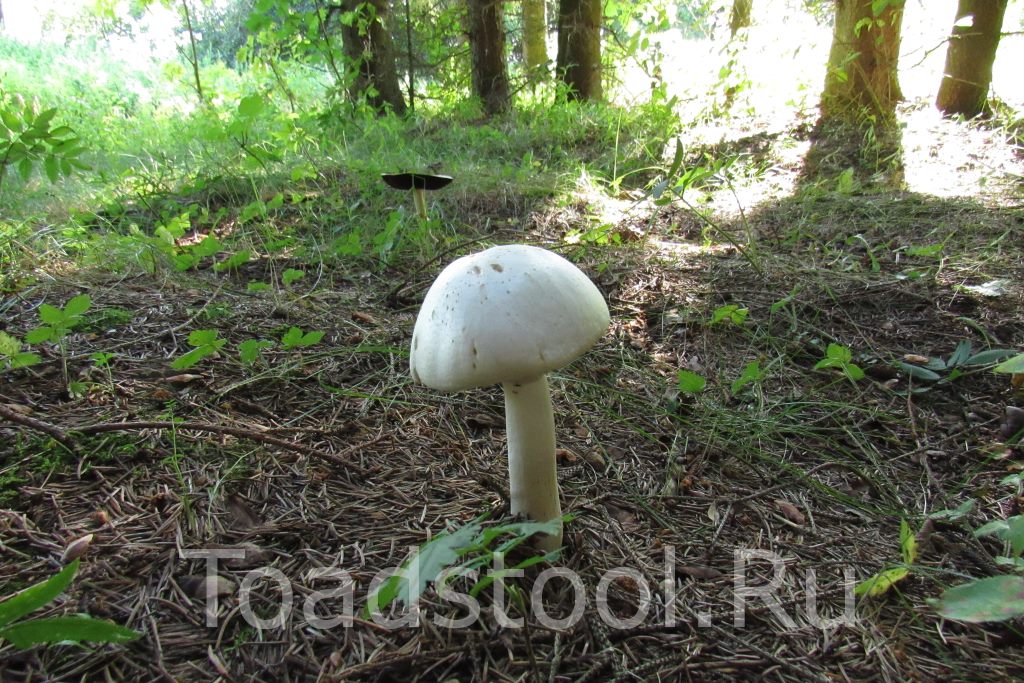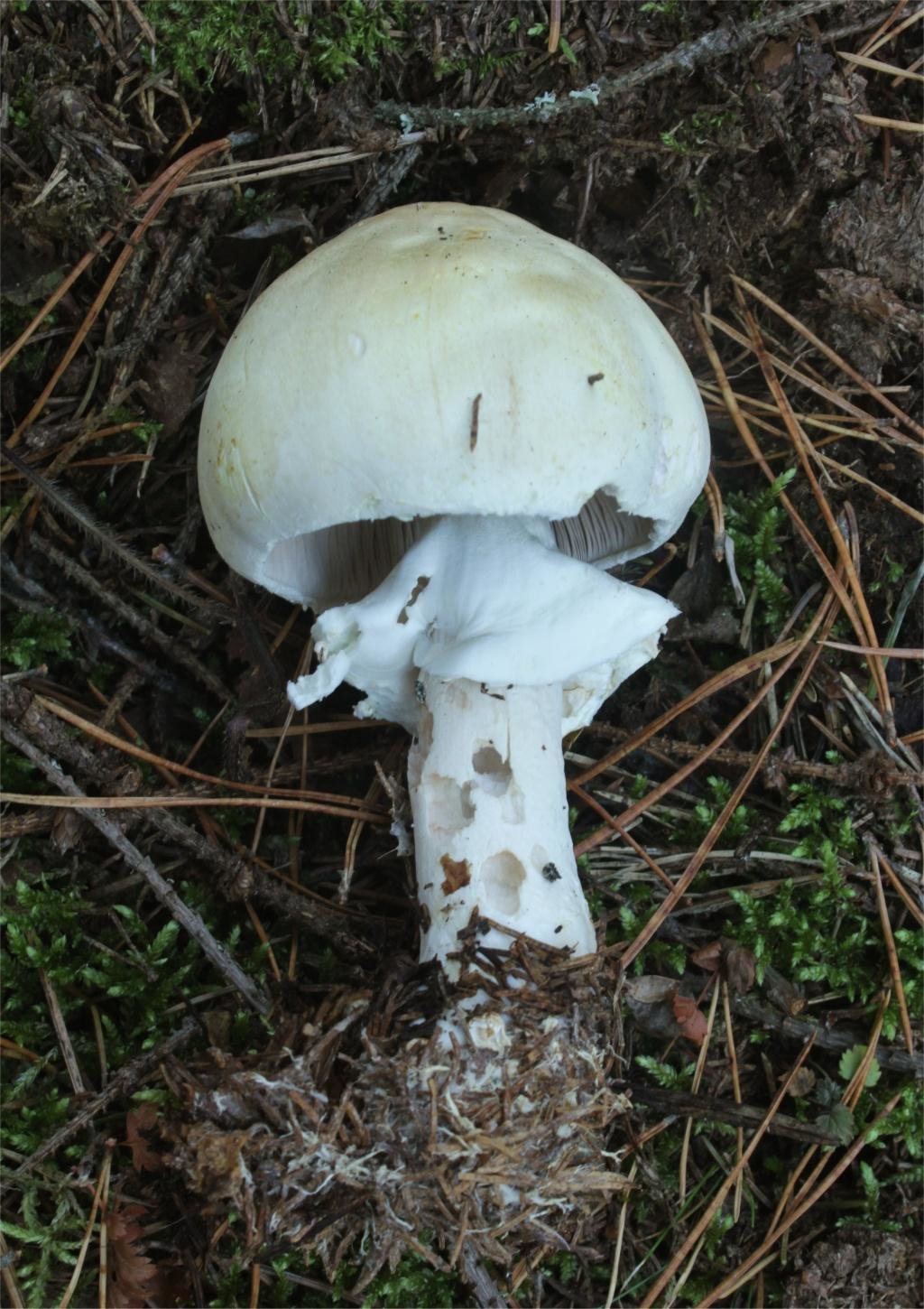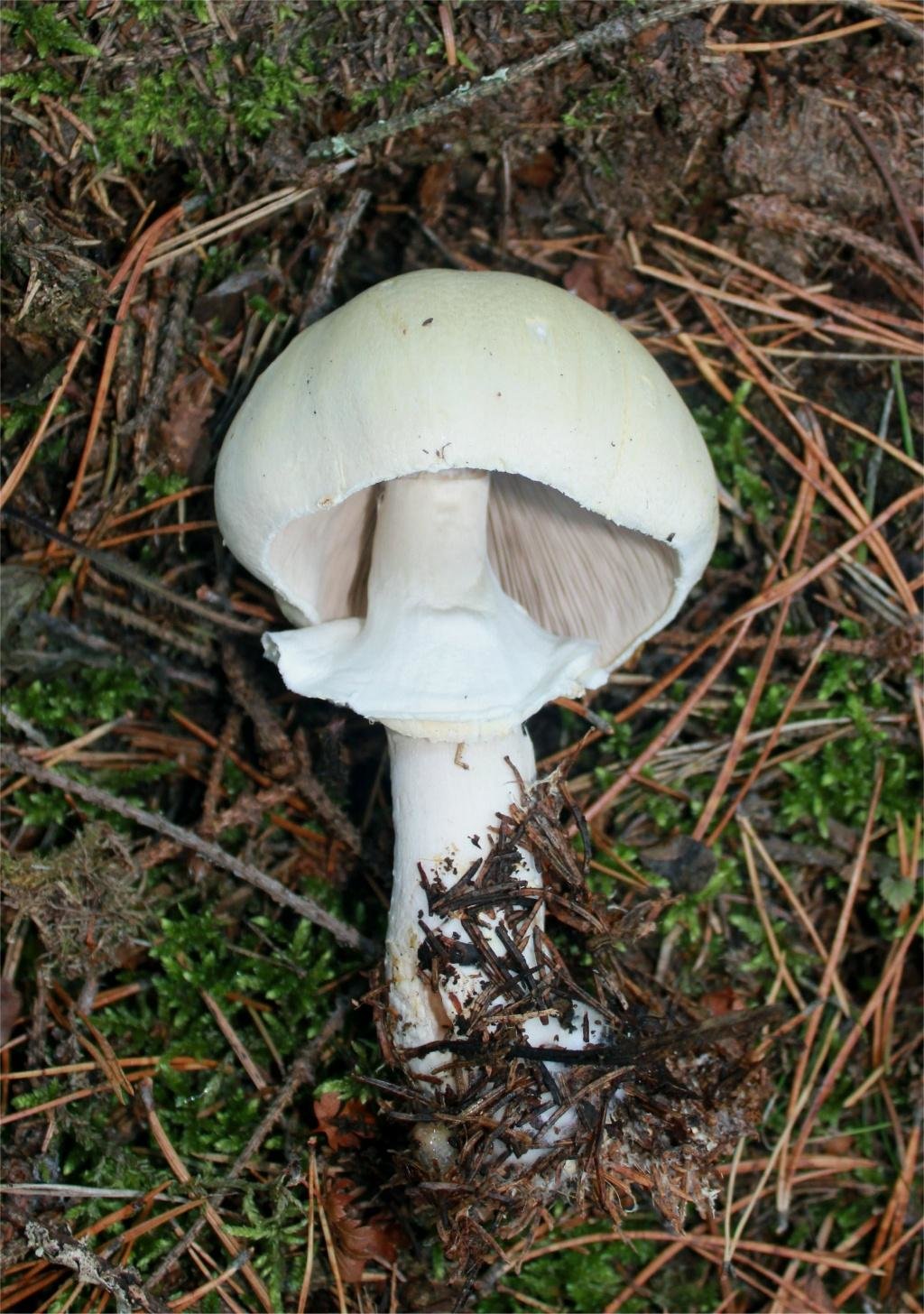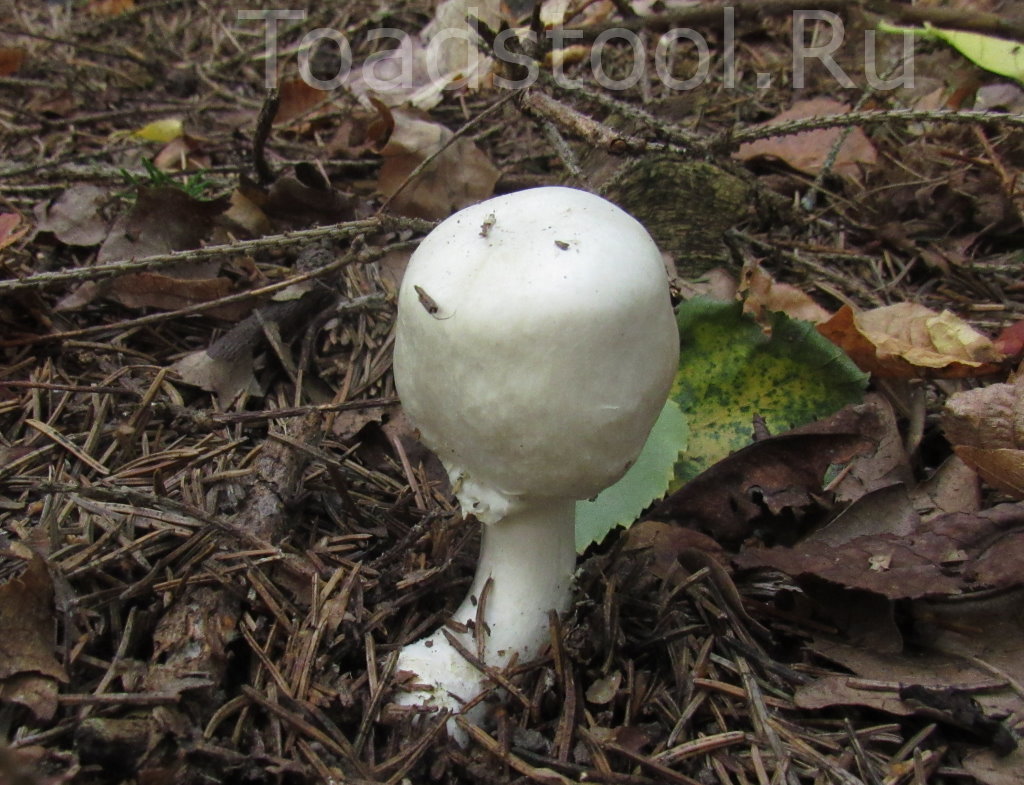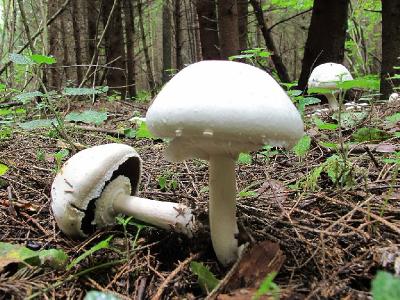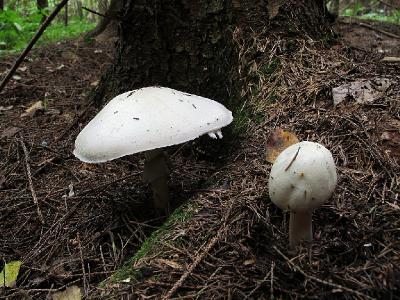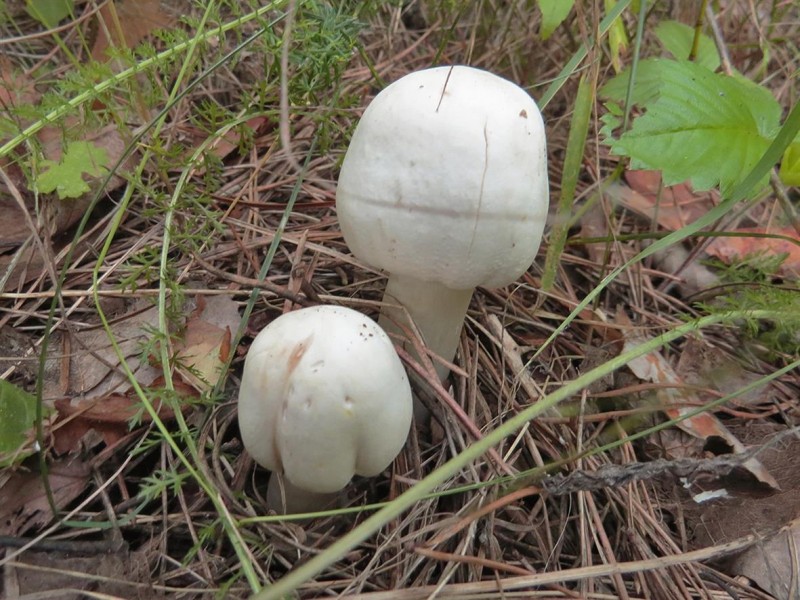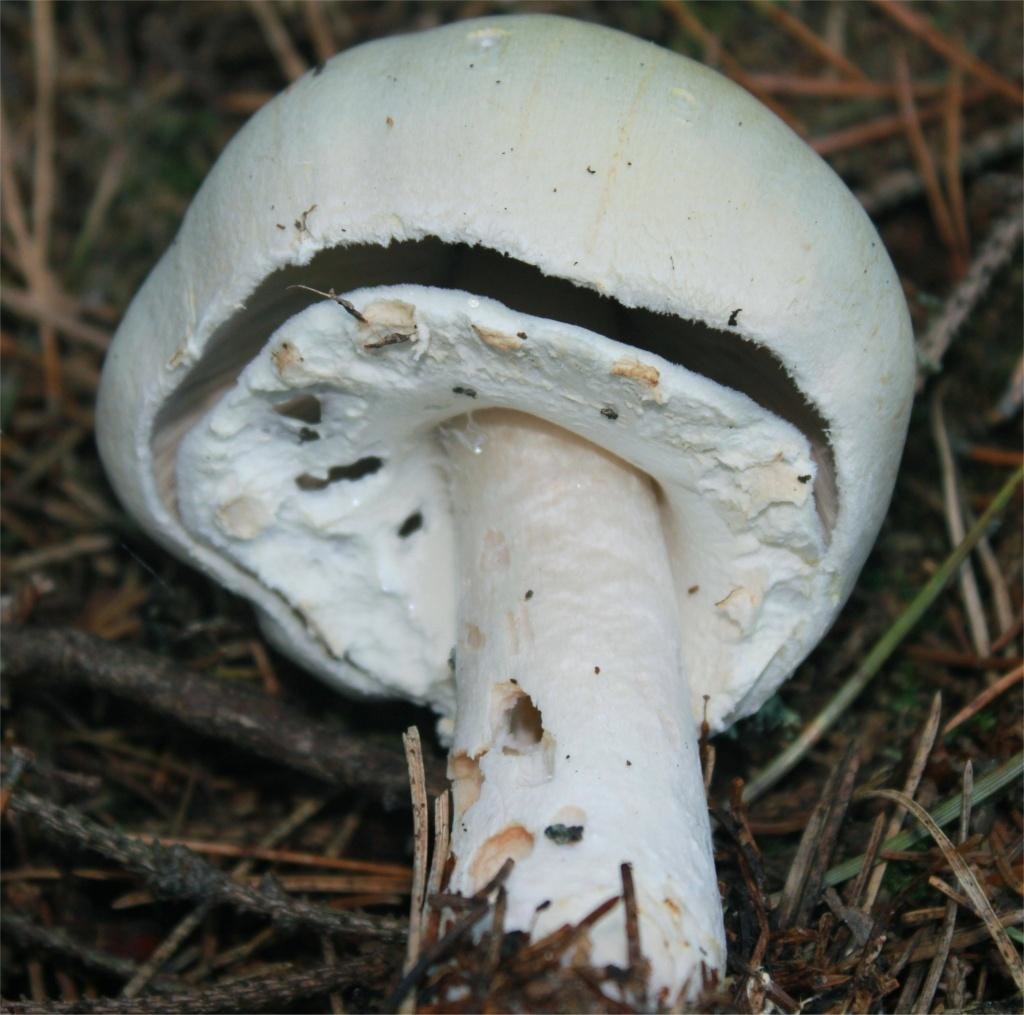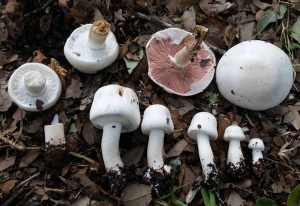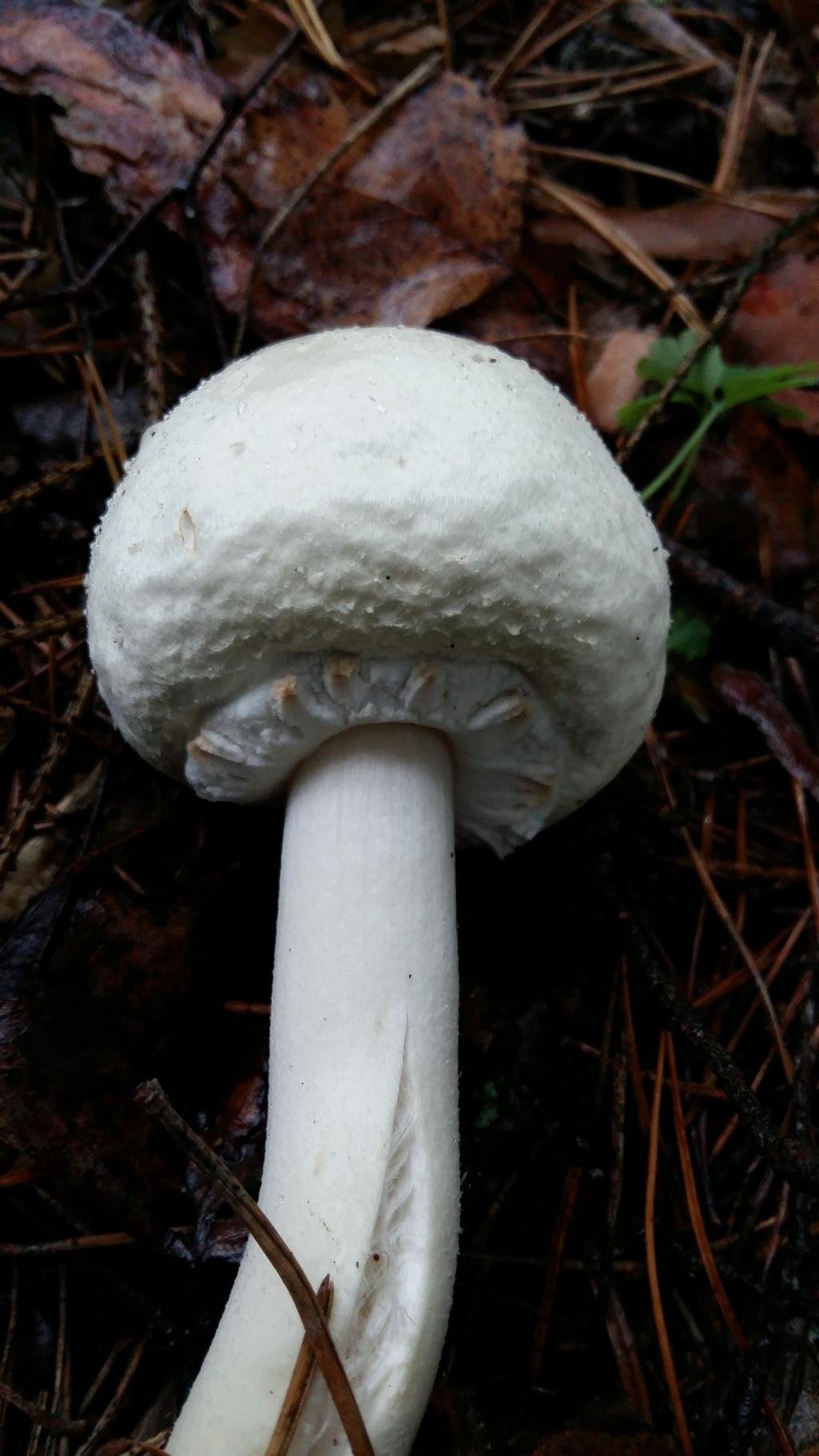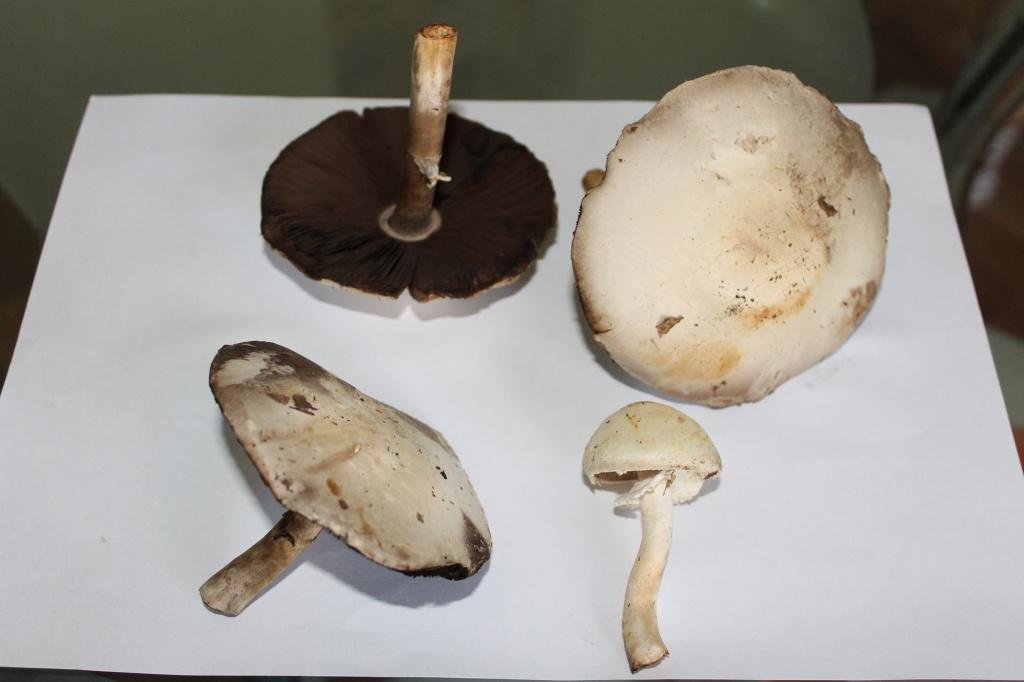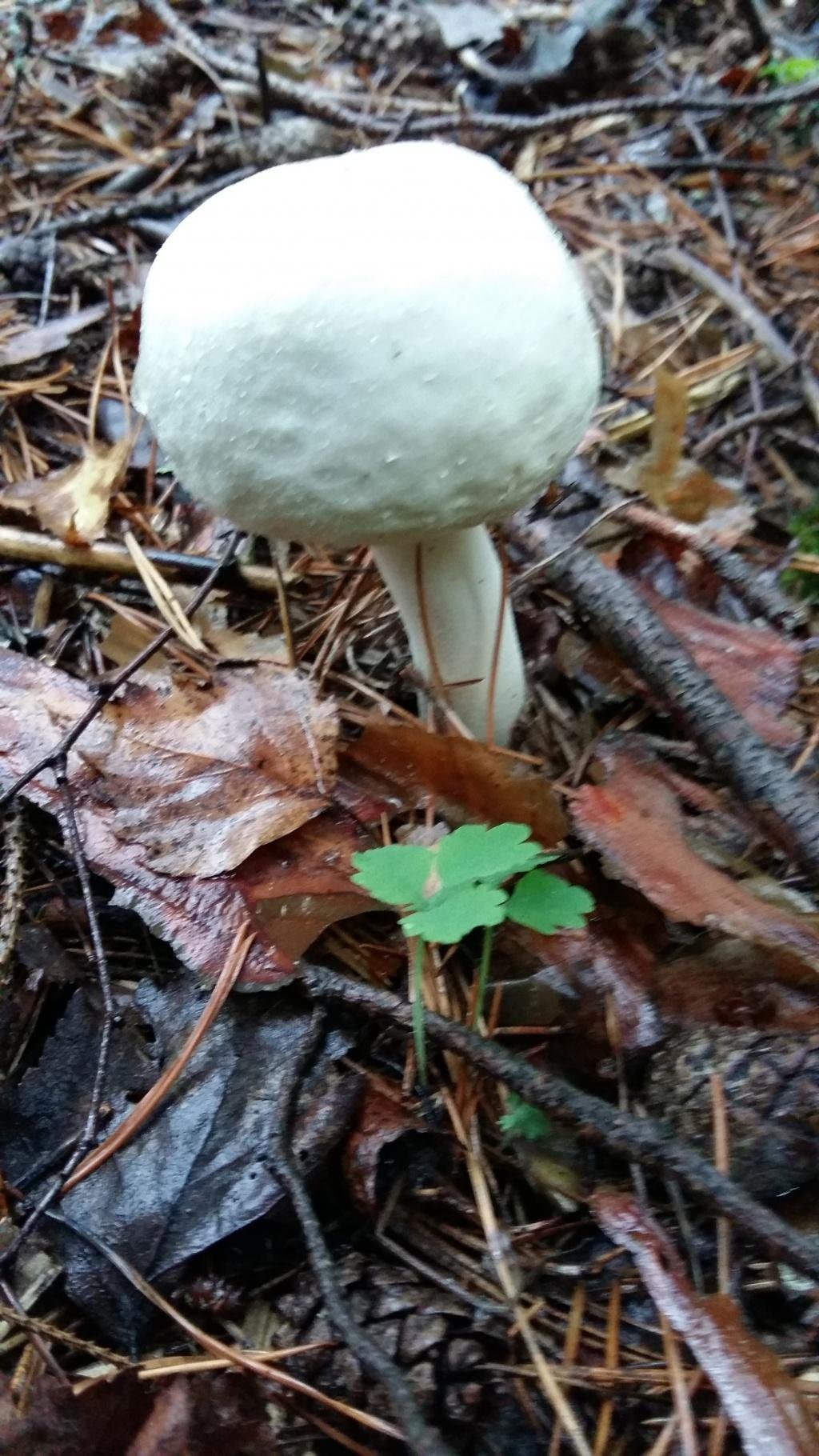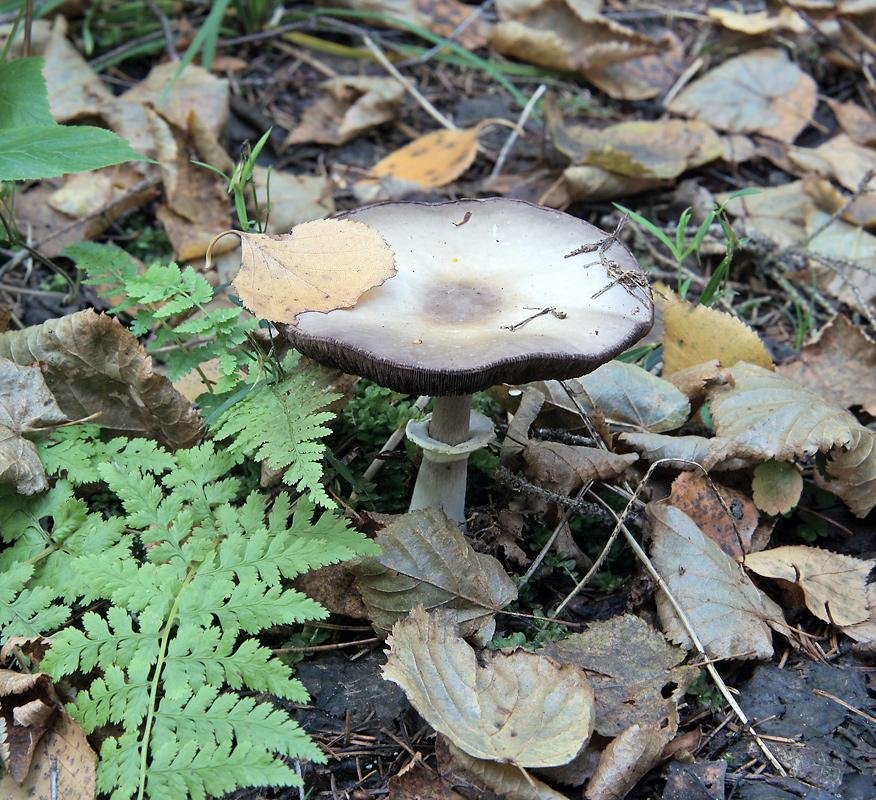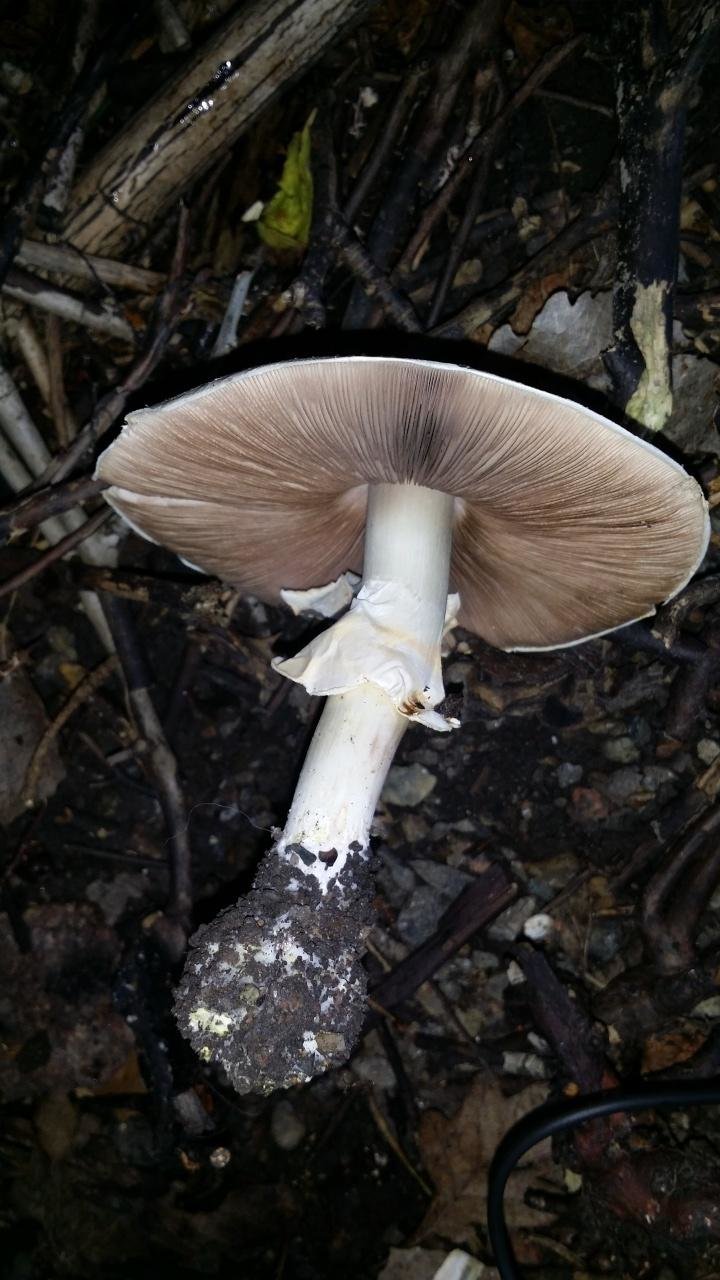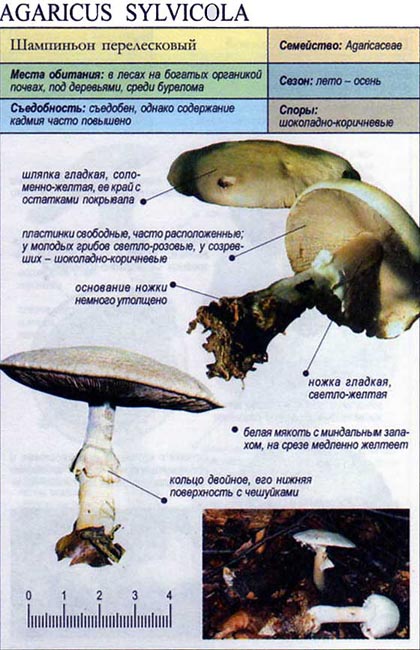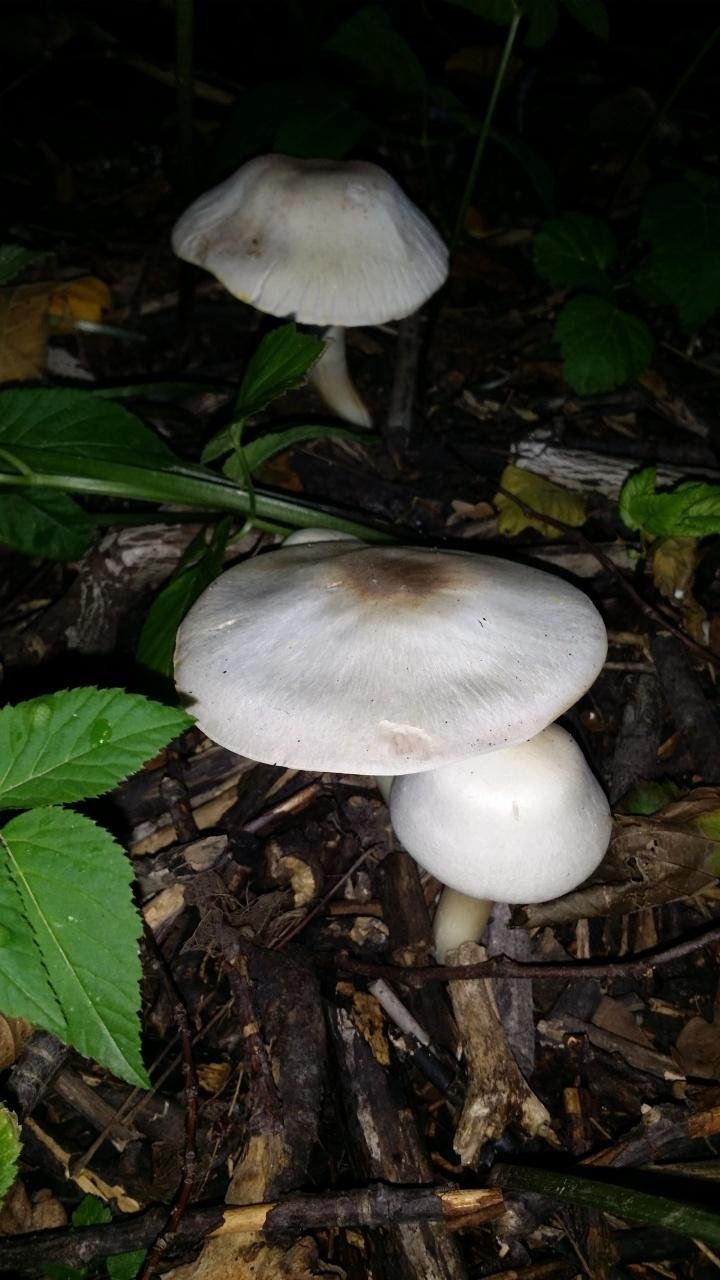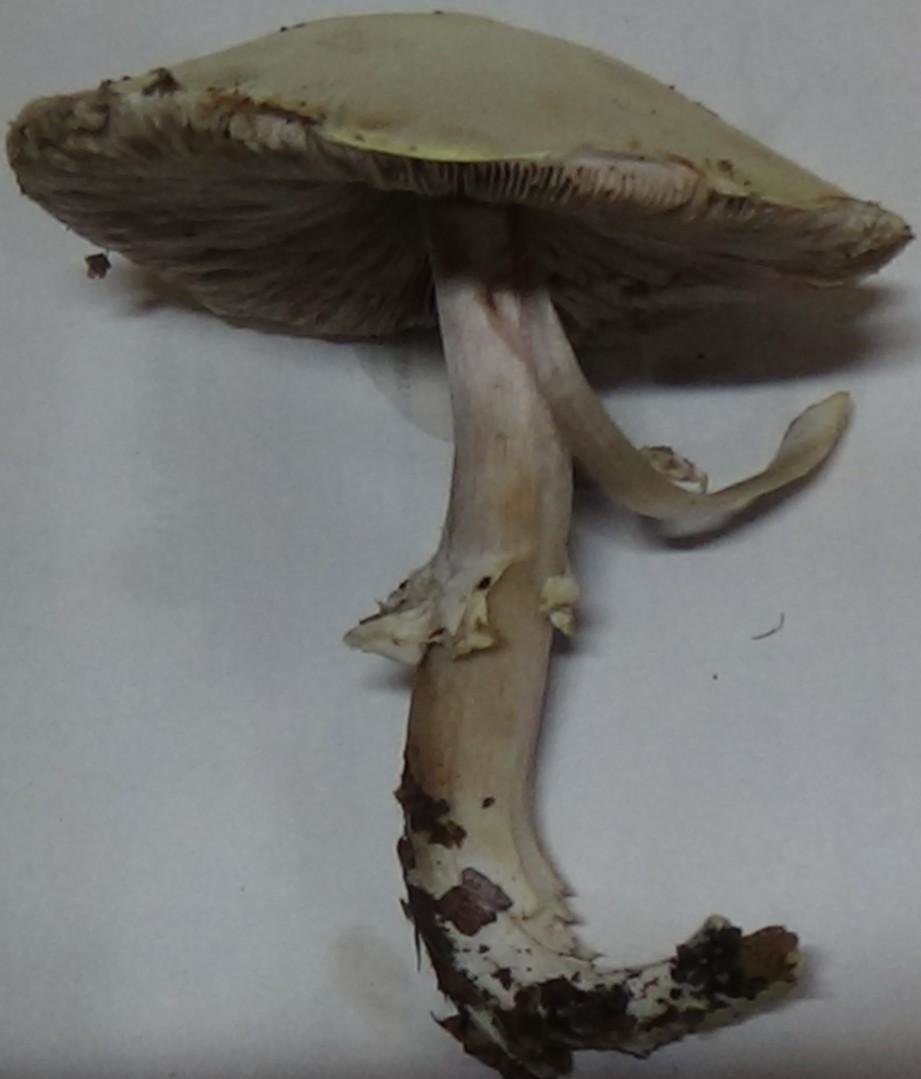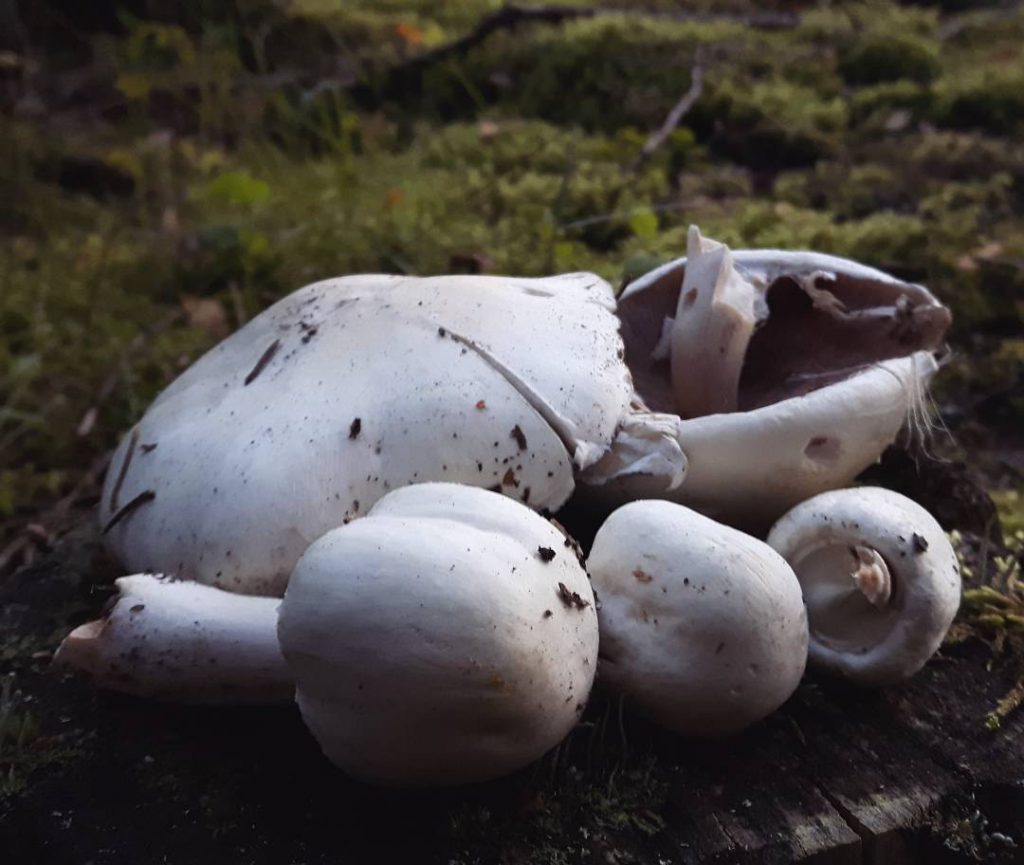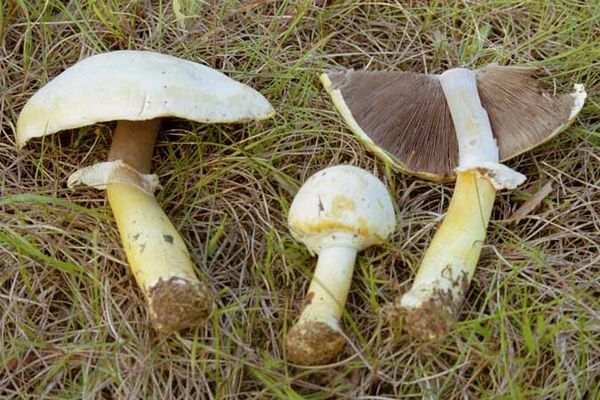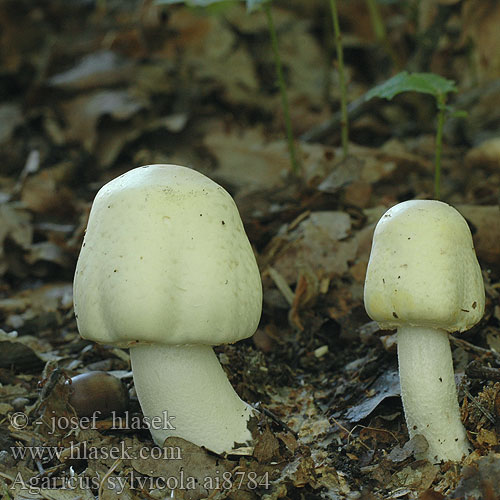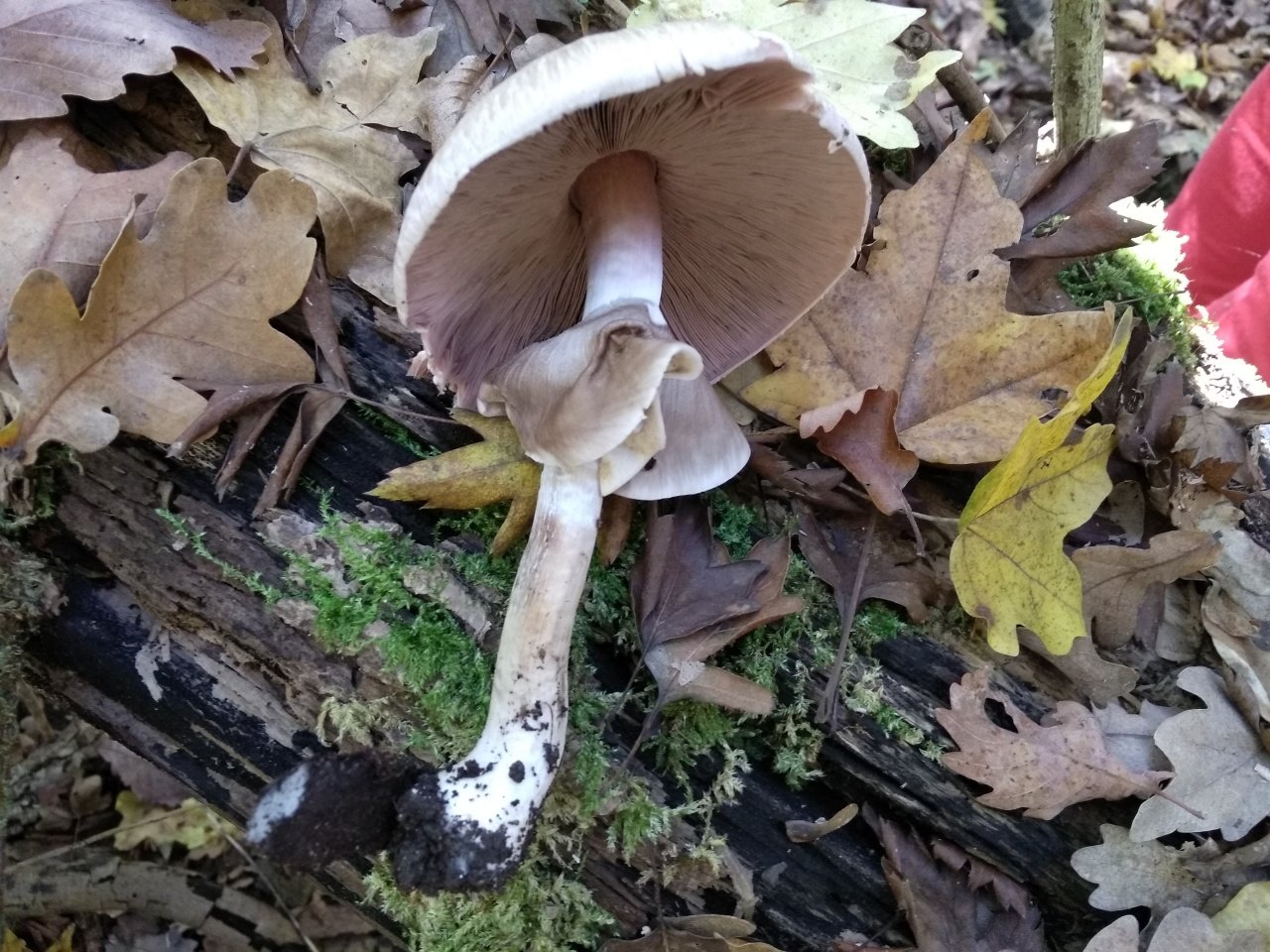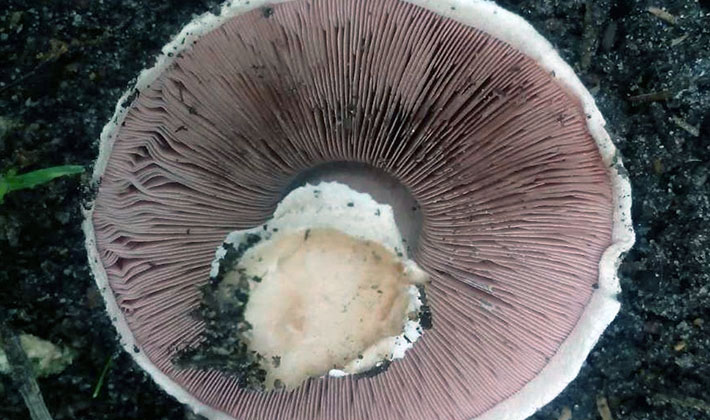Two-ring champignon
| Group: | Lamellar |
|---|---|
| Plates: | Pink, light brown |
| Colour: | White to light brown |
| Info: | The pulp turns pink at the cut |
| Department: | Basidiomycota (Basidiomycetes) |
|---|---|
| Subdivision: | Agaricomycotina (Agaricomycetes) |
| Class: | Agaricomycetes (Agaricomycetes) |
| Subclass: | Agaricomycetidae |
| Order: | Agaricales (Agaric or Lamellar) |
| Family: | Agaricaceae (Champignon) |
| Genus: | Agaricus (Champignon) |
| View: | Agaricus bitorquis (Two-ring champignon) |
The edible mushroom belongs to the second food category. Another representative of the champignon family.
If many other species are quite similar to each other and can be easily confused, then two-ring champignon can be recognized almost instantly, as soon as you pick it up. The word "chunky" suits this champignon perfectly. Fat meat, on an uncharacteristically short leg and already with two rings on it.
This variety has one more advantage. This champignon can be found much more often practically in urban areas than in the forest. But it is worth remembering that champignons are a real sponge for heavy metals and other harmful derivatives of human life. Therefore, you need to be extremely careful when picking mushrooms in urban areas.
Hat
The skin is dry, slightly rough to the touch, with sparse few scales near the center of the cap. The structure is dense, the old mushroom is loose, fleshy. The cap is colored from white to light brown. The edges of the cap are folded inward. In size it reaches from 6 to 12 cm. The skin is separated from the pulp with difficulty.
Spore-bearing layer
The plates are often located, not adherent. By old age, the color changes to a deep brown. The spore powder is brown.
Leg
Reaches 10 cm in height and up to 4 cm in diameter. Dense, powerful, with firm flesh. There are two leathery rings on the leg. The leg is painted white, sometimes with a cream shade, color.
Pulp
With a weak mushroom aroma and a slightly pronounced pleasant sourish taste. At the site of a break or cut, it slowly changes color from white to pink.
Distribution and collection
The two-ring champignon is one of those mushrooms that prefer to settle near human habitation and are quite rare at any distance from it. This mushroom can easily be found along the edges of paths, in parks, gardens, pastures and pastures. It is found, as a rule, in groups of 3-7 specimens.
Similar species
From the dangerous double of all champignons, the two-ring champignon is distinguished by the absence of an egg-shaped depression at the base, a darker hymenophore, a powerful constitution and a double ring on the stem.
Almost all champignons that can be found in our latitudes are in one way or another similar to the two-ring champignon. It is quite easy to distinguish it from its fellows:
- First, the ratio of the length of the stem to the general constitution of the fungus is striking; it is disproportionately short.
- Secondly, no other mushroom species has a double ring anymore.
Use
The double-ring champignon does not require any pretreatment. It can be used both raw in a salad and fried, boiled, stewed. Champignons can also be harvested in salted or pickled form, but they are much tastier when fresh.
Interesting Facts
Two-ring champignon is an extremely strong mushroom. If the fruit body grows under the asphalt or even the pavement, it is capable of lifting and breaking through even such a powerful obstacle.
Due to the short legs, this type of champignon is not cultivated on an industrial scale, since this feature excludes the machine method of picking mushrooms.
Yellow-skinned champignon
Yellow-skinned champignon - Latin Agaricus xanthodermus
In a different way, the mushroom is called the Yellow-skinned Pepper, the Yellow-skinned Fungus or the Red Champignon.
Description
Mushroom cap
Red champignon builds up a hat with a diameter of 50 to 150 mm. Young mushrooms appear with hemispherical caps, more mature ones acquire white yellow-skinned wide bell-shaped "headdresses". Closer to the center, they have cream or brownish blotches. If you press down on the hat, it will turn yellowish.
Yellow-skinned Pecher's hats are covered with tiny scales and filled with brownish pulp that smells like carbolic acid (this smell is also called pharmacy).
The hat bottom is equipped with thin white or pinkish plates growing to the legs, acquiring a brown-gray color by old age.
The emerging spore powder is dark brown in color.
Stipe
The yellow-skinned champignon has a stem 10-20 mm thick and 60-150 mm high, thickening downwards. It is equipped with a double ring, thick on the edge, and is painted white. The inside of the leg is empty, but at its base there is a little yellow pulp, and it sometimes takes on a reddish tint.
Growing places
Inedible champignons of this type are widespread throughout the planet, especially on the Australian continent, where they were brought specially, as well as in European and North American countries.
The fungus prefers deciduous and mixed forests, meadows, garden and park areas full of grass.
Fruiting is usually group: Yellow-skinned fungus often forms "witch circles". For medicinal purposes, it can be harvested in early July - late September. Especially a lot of mushrooms grow after heavy rains.
Edibility
The pulp of the yellow-skinned Pecheritsa emits an unpleasant inky or carbolic smell that does not disappear even after repeated boiling. On the contrary, after heat treatment, the fungus smells even more disgusting. The pulp of this mushroom has a very unpleasant taste.
It belongs to inedible mushrooms, as it contains toxic substances. They, penetrating the human body when eating mushrooms, lead to gastric poisoning, accompanied by diarrhea, vomiting, fever and other unpleasant symptoms
That is why, when picking mushrooms for food, it is important not to confuse edible champignons with their yellow-skinned counterpart.
Yellow-skinned champignon - Latin Agaricus xanthodermus
- Common champignon. This mushroom is widely used for the preparation of mushroom dishes. It does not emit an unpleasant carbolic odor (anise aroma comes from it), and its flesh turns pink after being cut.
- Coppice champignon. It smells like anise and has a flesh that turns buffy yellow when damaged.
Species table
| Name | From latin | Category |
|---|---|---|
| Elegant | Agaricus comtulus | good edible mushroom |
| Tabular | Agaricus tabularis | conditionally edible mushroom |
| Big forest | Agaricus mediofuscus | good edible mushroom |
| Carbolic | Agaricus placomyces Peck | inedible non-toxic mushroom |
| Crooked | Agaricus abruptibulbus | good edible mushroom |
| Field | Agaricus arvensis | good edible mushroom |
| Augustow | Agaricus augustus | good edible mushroom |
| Beneš | Agaricus benesii | good edible mushroom |
| Bernard | Agaricus bernardii | good edible mushroom |
| Cultivated | Agaricus bisporus | excellent edible mushroom |
| Two-ring | Agaricus bitorquis | good edible mushroom |
| Lugovoi | Agaricus campester | good edible mushroom |
| Dark red | Agaricus haemorrhoidarius | good edible mushroom |
| Large spore | Agaricus macrosporus | excellent edible mushroom |
| Motley | Agaricus meleagris | inedible non-toxic mushroom |
| Blushing | Agaricus semotus | conditionally edible mushroom |
| Forest | Agaricus silvaticus | good edible mushroom |
| Steam | Agaricus varoparius | good edible mushroom |
| Yellow-skinned | Agaricus xanthodermus | toxic mushroom |
| Redhead | Agaricus xanthodermus | toxic mushroom |
What is PCB made of?
Textolite is a complex material that is made from several components. The base of the sheet is cotton fabric, which is impregnated with special compounds, and then pressed to the desired thickness.
As impregnation, various resins are used, which are selected based on the desired final properties.
In the production of PCB, fabric can also be used in various thicknesses, densities, impact resistance and cracking.Chiffon, belting, calico and some others are used as the main varieties.
The technological process for the production of PCB includes the following operations:
- preparation of impregnation - resin based on alcohol solution;
- impregnation of fabric in filled baths at t solution of about 40 ° C;
- running the fabric through the pressing rollers, where a uniform redistribution of the resin also occurs;
- drying in thermal chambers at 120 ° C;
- final processing of dried fabric: forming, trimming, additional press processing, cooling, sending to the warehouse.
Yellow-skinned champignon
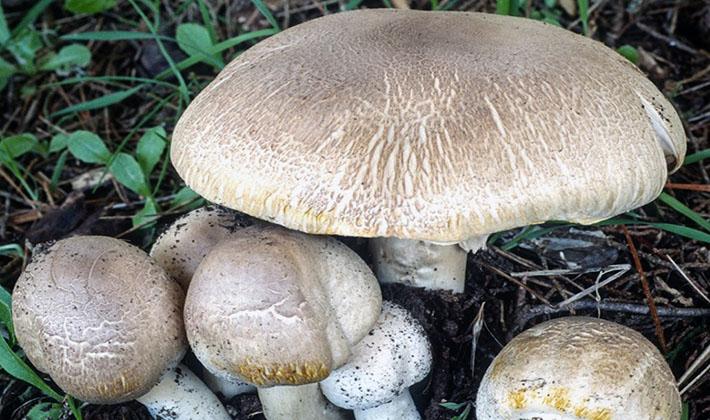 The habitat of the yellow-skinned champignon (Agaricus xanthodermus): among the grass, on humus-rich soil, in gardens, parks, pastures, near dwellings.
The habitat of the yellow-skinned champignon (Agaricus xanthodermus): among the grass, on humus-rich soil, in gardens, parks, pastures, near dwellings.
Season: May-October.
The cap is 6-15 cm in diameter, at first spherical with edges curved inward, later flat-rounded and then prostrate, often with a convex center, silky or fine-scaled. The color of the cap is first white, later yellowish with brownish or grayish-brown spots. The edges often have remnants of a private bedspread.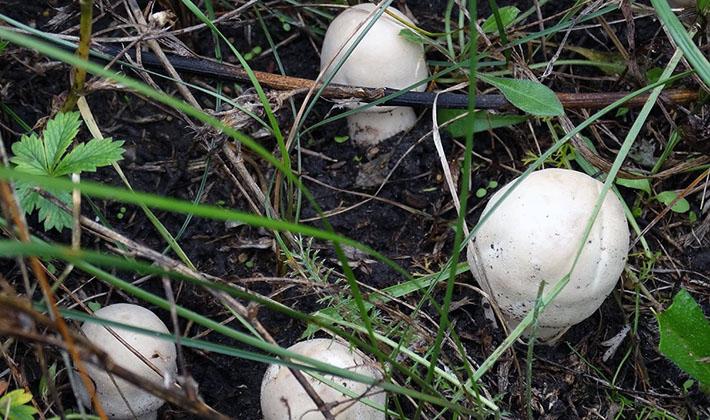
The stem of this type of champignon mushrooms is 5-9 cm high, 0.7-2 cm thick, smooth, straight, even or slightly widened at the base, the same color as the cap. In the middle of the leg there is a wide double white ring. The bottom of the ring has scales.
Pulp. A distinctive feature of this forest species is the intensely yellowing white pulp in the cut and the smell of carbolic acid or ink, especially during cooking. This smell is often referred to as "pharmacy" or "hospital" smell.
The plates are at first whitish or pink-gray, then the color of coffee with milk, frequent, free. When fully ripe, the plates acquire a dark brown color with a purple tint.
Similar species
This species is poisonous, therefore it is so important to distinguish it from edible similar species. These champignons look like common edible champignons (Agaricus campester), which, with all other similar features in the color of the cap, the shape of the leg and plates, is distinguished by the absence of a "pharmacy" smell or the smell of carbolic acid
In addition, in the common champignon, the flesh on the cut slowly turns red, and in the yellow-skinned mushroom it turns intensely yellow.
These photos show what yellow-skinned champignons look like:

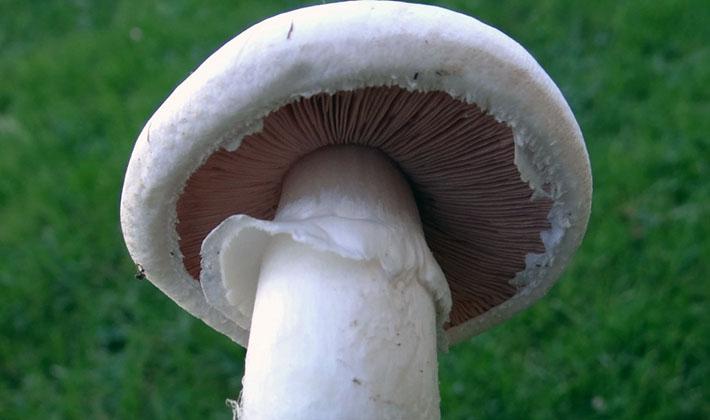
Description
The cap is 5-10 cm in diameter, at first ovoid, then convex, in old mushrooms it opens up to flat. The skin is smooth, satiny or silky, white or creamy, in old mushrooms it becomes light brown or grayish, and becomes covered with lemon-yellow spots from touch.
The flesh in the cap is thinner than that of other mushrooms, white, slowly acquires an ocher-yellow color on the cut, has a strong aniseed smell (according to some sources - almond).
The leg is 8-12 cm long and 1-2 cm in diameter, slender, with fibrous pulp, becomes hollow with age, with a rounded thickening at the base up to 3 cm.
free, very frequent, wide. Their color changes with age from pure white or grayish to pink, brown with a whitish border around the edges, and then almost black with a chocolate tint.
The remains of the veils: the ring on the leg is double, leathery, very wide, hanging down, flabby in old mushrooms. Its upper side is white, later colored by falling out spores, it is scaly, the lower one is grayish. Volvo is missing.
Spore powder chocolate brown or dark brown, spores 7 × 4.5 μm, ellipsoidal.
Similar species and how to distinguish from them
This champignon has counterparts - as a rule, other types of this kind of mushrooms:
- meadow (Agaricus campestris);
- curve (Agaricus abruptibulbus);
- coppice (Agaricus silvicola).
Field champignon differs from them in larger size and place of growth. For example, the curve grows in forests, hiding from the sun, and meadow, as the name implies, likes to settle in meadows. Coppice, like the curve, does not like open spaces.
Fortunately, all these mushrooms are edible, but inexperienced lovers of "quiet hunting" can confuse champignon with poisonous and often deadly representatives of the mushroom kingdom:
- stinky fly agaric or white toadstool (Amanita virosa);
- pale toadstool (Amanita phalloides);
- fly agaric (Amanita citrina);
- spring toadstool or spring fly agaric (Amanita verna).
But, looking closely, one can notice significant differences between these mushrooms - all the poisonous ones on the stem, in its lower part, have a saccular thickening - volva, the plates do not change their color, remaining white, and the surface integuments on the fruiting body do not turn yellow when damaged.
Also, due to inexperience, champignon can be confused with false value (Hebeloma crustuliniforme): in the latter, the cap has a pinkish or slightly yellowish tint, darkening towards the central part, the leg is covered with scales, and it smells like horseradish, but not anise, like champignon.
Among the genus of champignons there is a similar poisonous species - yellow-skinned (Agaricus xanthodermus). It is small in size and differs from the field in its characteristic pharmacy smell. Also, the main difference is that its pulp, if damaged, turns yellow very quickly.
Properties and classification
In practice, a wide variety of material properties are widely used, which textolite can be endowed with:
- chemical inertness;
- high strength, including when exposed to bending and compression;
- high electrostatic properties;
- good toughness;
- pliability to mechanical processing.
It is the last property that determines the wide range of parts that can be manufactured on the basis of a conventional sheet. It is also characteristic that the strength index can be varied taking into account the area of use by changing the thickness of the material.
A characteristic feature of the material is the difference in some properties depending on the direction of the impact. So, the ultimate strength in compression and bending increases in the perpendicular direction to the laid layers, which must also be taken into account in the manufacture of parts.
Along with the physicochemical properties, it is possible to note the noiselessness of the textolite in operation, ease of processing, which is also actively used in production, maintenance of machines and during repair work.
In production, two different types of products based on sheet textolite have become widespread:
- Constructional textolite. This material can be in demand for two brands - PTK and PT. The first type is used for the manufacture of various bushings, sleeve bearings, and has a sufficiently high strength to work in mechanisms. Textolite of the PT brand (ornamental) is used for the manufacture of various piece parts, such as gaskets, rings, where resistance to high loads is not so typical. The compressive stress of these grades corresponds to values of 160 and 155 MPa.
- Electrotechnical textolite. This material can be manufactured under the indexes A, B, VCh, LT. Each variety stands out for its characteristic properties. Thus, the “A” brand is famous for its high insulating properties, the material under the “B” index is better known for its high strength characteristics, and the LCh textolite retains its performance characteristics at high humidity and in a wide temperature range. The volumetric electrical resistance is 106 Ohm × m3.
Champignons - type, description of mushrooms, where they grow in nature
Main types and characteristics
Champignons are the most popular mushrooms in our time. They are very tasty, healthy and even medicinal, as they contain proteins, carbohydrates and mineral salts. In terms of nutritional value and nutritional value, mushrooms are equated to meat.
These mushrooms can be easily recognized by their appearance. Usually white and less often brown fleshy caps. The pulp is white, but when interacting with oxygen it changes color to red or yellow. The plates in young specimens are pinkish. Over time, they acquire a brown color.The leg is dense, white, up to 10 cm high.
Here are the most popular of them, which won the love of mushroom pickers and ordinary people:
- Garden (double-sided). It grows on cultivated and fertilized soils - in a greenhouse, in a vegetable garden and pasture. In the wild, it is found in temperate countries of Europe, where the soil is completely free of grass cover. Juicy light flesh, which turns pink when broken. White leg, almost hollow, cylindrical in shape.
- Steppe (Bernard). The main place of its growth is desert or semi-desert. This type of champignon loves saline soils. Grows in groups. Can be confused with common champignon. The color of the cap is varied: from white to brown. Plates are located below the cap. The leg is of the same color as the head.
- Two-ring. The people also have the name sidewalk or city mushroom. This is an unpretentious and sharply different champignon from other mushrooms in its family. A rather large hat sits on a fleshy low leg. Loves a warm climate. Fruiting from late May until November.
- Dark scaly. Occurs in deciduous or mixed forests from July to September. The hat is convex. The plates are wide and sparsely located. Hollow white leg. The pulp of the mushroom is also white when pressed, first turns yellow, then turns brown.
- Small-scaled (Benesha champignon). It grows in both coniferous and deciduous forests. His flesh is white, but when pressed, it quickly turns red. In cooking, they are often consumed raw. This species can be called stocky, since a fleshy cap sits on a low, but very dense leg. The plates are located close to each other, pinkish hue.
- Steam. Found throughout Europe in mixed forests. It can also grow in meadows and pastures. Does not like direct sunlight. It is usually harvested in the autumn. The hat has a rounded shape that is covered with scales. There are many thin plates under it. The stem itself is of medium length, but goes deep into the soil and has a thickening at the base. The pulp is white and fleshy, with an interesting chicory scent.
- Augustowski. A rare type of champignon found in Europe. They grow in groups from August to October in the park area, near anthills. The cap, like that of other representatives of champignons, changes shape over time, and is covered with orange-brown scales. The pulp has a pleasant almond scent. The mushroom is quite tall.
- Large spore. It grows in Eurasia. Loves meadow soils rich in organic matter. This species is quite large. The cap is smooth and convex, on which large scales appear over time, and the edges become velvety. Such a cap can only be held by a dense high leg, which thickens at the base. A ripe large-spore mushroom has a peculiarity - a smell that flows from a pleasant almond to a pungent smell of ammonia.
A dangerous resemblance.
The pale toadstool has an external resemblance to the coppice champignon. There is a great risk of confusion. Everyone should know the signs by which a toadstool can be distinguished from a mushroom. The plates of the white toadstool do not change their color, they remain white even in old specimens, and in champignons they become darker over time. Therefore, if a small mushroom with pale blades is found, it cannot be harvested, since it is a pale toadstool.

Related species of coppice champignon.
The yellow-skinned champignon is a poisonous relative of the coppice champignon, but it is usually larger. His cap is yellow-skinned with brownish blotches in the central part. The shape of the cap is bell-shaped, rounded, rather large. The leg is hollow, white, with a two-layer ring. The pulp emits a strong phenolic odor during heat treatment.
It is a very poisonous species that causes frustration and vomiting. Active fruiting occurs from summer to autumn.Especially yellow-skinned champignons are plentiful after rains. They grow in mixed forests. Yellow-skinned champignons are common all over the world.

Curve champignon can also be confused with coppice champignon. But the crooked champignon is thinner and taller. It is an edible species. His hat looks like a dull bell, and then it becomes open. Its color is white or cream, and when pressed, it turns yellow. The stem is cylindrical, even, with a tuberous base. There is a hanging, single-layer ring on the stem. The pulp is firm, white or yellowish, with an aniseed scent.
Crooked champignons grow in coniferous forests. Fruiting occurs from summer to autumn. This type of mushroom can be found on the forest floor. Crooked champignons are found in groups, but sometimes they settle alone.


